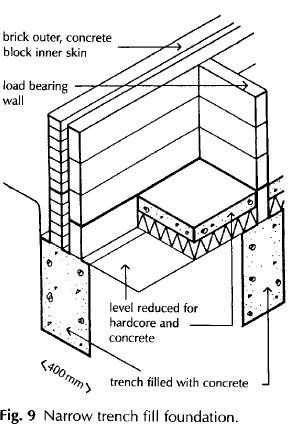Stiff clay subsoils have good bearing strength and are subject to seasonal volume change. Because of seasonal changes and the withdrawal of moisture by deep rooted vegetation it is practice to adopt a foundation depth of at least 0.9 m to provide a stable foundation.
Because of the good bearing capacity of the clay the foundation may need to be little wider than the thickness of the wall to be supported. It would be laborious and uneconomic to excavate trenches wide enough for laying bricks down to the required level of a strip foundation.
Practice today is to use a mechanical excavator to take out the clay down to the required depth of at least 0.9 m below surface and immediately fill the trenches with concrete up to a level just below finished ground level, as illustrated in Fig. 9. The width of the trench is determined by the width of the excavator bucket available, which should not be less than the minimum required width of {foundation}.

The trench is filled with concrete as soon as possible so that the clay bed exposed does not dry out and shrink and against the possibility of the trench sides falling in, particularly in wet weather.
With the use of mechanical excavating equipment to dig the trenches and to move the excavated soil and spread it over other parts of the site or cart it from site, and the use of ready mixed concrete to fill the trenches this is the most expedient, economic and satisfactory method of making foundations on stiff, shrinkage subsoils for small buildings.